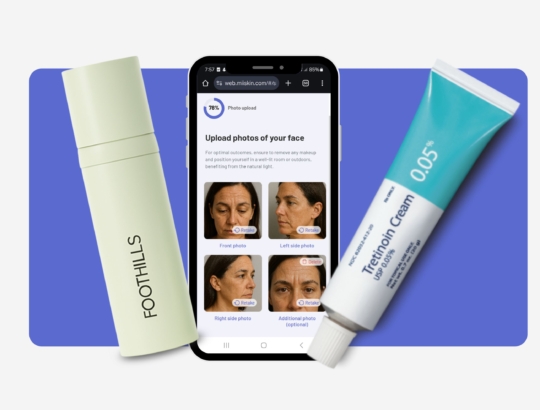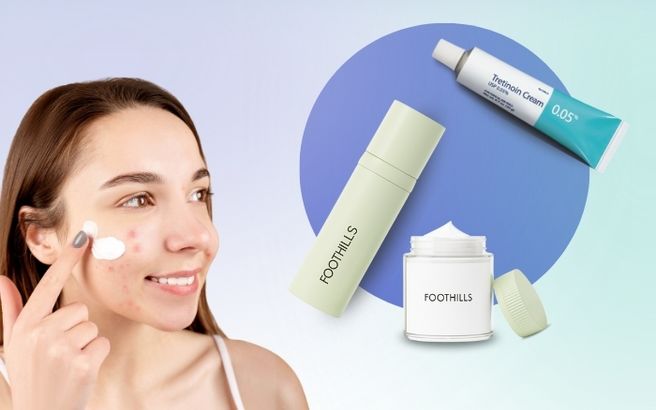Understanding combination skin: Tips for a balanced skincare routine
Dr. Alpana Mohta, board-certified dermatologist talks about the best skin care ingredients for combination skin and puts together a morning and evening skincare routine for this type of skin.
Covered in this article:
What is combination skin? | How do I know if I have it? | Best ingredients | How can I get a prescription? | Morning skincare routine | Evening skincare routine | FAQ
Our commitment to producing high-quality content:
The information presented in this article is based on scientific research and the professional advice of our Content Medical Reviewers, who are experts in the field of Dermatology. How we write our content →
What is combination skin?
Dr. Alpana Mohta, board-certified dermatologist, says that combination skin is a type of skin that has both oily and dry areas, often at the same time. It is characterized by a mix of skin types on different parts of the face, leading to a unique set of skincare challenges.
Common characteristics of combination skin
- Oily areas: Typically, the “T-zone” (forehead, nose, and chin) is oily. This area tends to produce more sebum (oil), leading to a shiny appearance, larger pores, and sometimes breakouts.
- Dry or normal areas: The cheeks, jawline, and eye area are often dry or normal. These areas may feel tight, rough, or sensitive, especially after cleansing.
- Seasonal or environmental changes: Combination skin can fluctuate based on the weather or environment, becoming oilier in humid or warmer months and drier in cooler ones.
- Sensitivity: Some individuals with combination skin may also have sensitive areas, especially over cheeks, which can react to harsh products.
How do I know if I have combination skin?
Dr. Mohta says that you have combination skin if you have both oily and dry areas. The T-zone (forehead, nose, and chin) often appears oily, shiny, or prone to breakouts, while the cheeks and jawline may feel dry, tight, or normal. If you notice that some areas of your face are oily while others are dry or sensitive, you likely have combination skin.
What are the best ingredients to use for combination skin?
According to Dr. Mohta, these are 7 key ingredients that are beneficial for combination due to their properties and benefits for the skin. However bear in mind that you cannot use all these ingredients at the same time or on the same day as your skin can become quite irritated by them. She recommends consulting your online dermatologist via Miiskin for tailored advice.
- Tretinoin: This prescription retinoid helps reduce oil production, unclog pores, boost collagen production and improve skin texture1.
- Niacinamide: A form of Vitamin B3 that helps balance oil production, reduce redness, minimize pores, and improve the skin’s texture2.
- Hyaluronic Acid: A powerful humectant that draws moisture into the skin, providing lightweight hydration without clogging pores, making it ideal for both oily and dry areas3.
- Salicylic Acid (BHA): An oil-soluble exfoliant that penetrates into pores to remove excess oil and dead skin cells, preventing breakouts while being gentle enough for combination skin4.
- Glycolic Acid (AHA): A water-soluble exfoliant that smooths skin texture, brightens the complexion, and gently exfoliates the surface without stripping moisture.
- Peptides: Short chains of amino acids that promote collagen production, improve skin firmness, and enhance hydration while soothing sensitive or dry areas5.
- Azelaic Acid: A multi-functional ingredient with anti-inflammatory, antibacterial, and brightening properties. It helps regulate oil, treat acne, reduce redness, and even out skin tone6.
How can I get prescription-strength ingredients for my combination skin?
You can have a consultation with a board-certified dermatologist through Miiskin and you can get customized formulas for your skin. Consultation price starts at $59 and medication renewals are only $39.
Dermatologist-approved combination skin care routine
Dr. Mohta describes an example of a skin care routine for combination skin, but she recommends you consult a dermatologist before starting a skincare regime with multiple ingredients at the same time as they may not be suitable for you due to your personal circumstances.
Morning skincare routine for combination skin
- Use a gentle gel or foaming cleanser to remove excess oil without stripping the skin. Look for formulas that contain ceramides to help maintain the skin barrier while keeping oil in check.
- Apply prescription-strength azelaic acid to problem areas like the T-zone or spots prone to breakouts. This ingredient helps with redness, acne, and hyperpigmentation without irritating dry areas.
- Use a Vitamin C serum. It’s an antioxidant that protects the skin from environmental damage induced by the sun and pollutants, boosts collagen production, and brightens uneven tone. This step is crucial to enhance radiance without increasing oiliness.
- Opt for a lightweight hyaluronic acid-based moisturizer that hydrates without clogging pores. This ingredient attracts moisture, keeping dry areas comfortable while preventing oily areas from becoming greasy.
- Apply a broad-spectrum sunscreen with SPF 50 and PA ++++ or higher to protect against UV damage. Use a gel-based or matte formula to avoid adding shine to the T-zone.
Evening (nighttime) skincare routine for combination skin
- For the nighttime routine, Dr. Mohta recommends double cleansing in oily or combination skin, especially for people who wear makeup or silicone-based sunscreen daily.
- Instead of an oil cleanser, micellar water or non-greasy cleansing balm is preferred for such skin types.
- Apply a nighttime moisturizer containing ceramides and peptides. This will help repair the skin barrier, lock in moisture, and support skin elasticity while you sleep.
- Apply a pea-sized amount of tretinoin to help with acne, texture, and anti-aging. Use 3-5 nights per week, starting with a lower strength if you’re new to retinoids. Avoid sensitive areas like the corners of the mouth and around the eyes. It’s best to stick to a lower-strength tretinoin formulation (such as tretinoin 0.025) for combination skin.
- On the two nights you don’t use a retinoid, opt for a chemical exfoliant to remove dead skin cells and unclog pores. Choose either salicylic acid or glycolic acid if you’re targeting overall brightness and texture.
- Apply a hyaluronic acid or niacinamide serum to soothe the skin
- If you have dryness or signs of aging around the eyes, consider an eye cream with peptides to reduce fine lines and hydrate the delicate eye area.
This routine is designed to balance combination skin by offering hydration, gentle exfoliation, and targeted treatments without overloading oily or sensitive areas., you can choose professional treatments such as chemical body peels and laser treatments to improve texture, reduce pigmentation, and promote smoother skin.
Frequently asked questions about combination skin
What skincare is best for combination skin?
Dr. Mohta says that the best skincare products for combination skin include gentle, non-stripping cleansers, lightweight moisturizers, and targeted treatments for oily areas. Look for products with ingredients like niacinamide to balance oil, hyaluronic acid to hydrate, and lightweight sunscreens to protect without adding shine. A routine that includes gentle exfoliation and barrier-strengthening ingredients will help keep combination skin balanced.
How can I know my skin type?
Dr. Mohta says to determine your skin type, wash your face with a gentle cleanser and wait an hour without applying any products. After an hour, observe how your skin feels: oily, dry, or a mix of both. If some areas (like the T-zone) are shiny while others feel dry or normal, you have combination skin. You can also consult a dermatologist for a more precise analysis.
What not to use on combination skin?
Dr. Mohta says you should avoid heavy, occlusive creams that can clog pores in oily areas or overly harsh, drying cleansers that strip the skin, leading to increased oil production. Steer clear of products with high alcohol content and abrasive physical exfoliants, which can irritate both oily and dry regions.
What makes combination skin worse?
Dr. Mohta says that over-cleansing or using hot water for cleansing, harsh ingredients, exfoliating scrubs, and skipping moisturizer can worsen combination skin. These habits can trigger the skin to produce more oil in oily areas while making dry areas drier. Environmental factors like extreme weather, pollution, and sun exposure can also exacerbate combination skin.
Is combination skin more oily or dry?
Dr. Mohta says that combination skin is generally more oily in the T-zone and more dry or normal on the cheeks. The balance of oiliness versus dryness can vary depending on the season, environment, or specific skin care products used.
Is combination skin rare?
No, Dr. Mohta says combination skin is not rare. It is actually one of the most common skin types, especially among younger individuals and those experiencing hormonal changes, which can lead to different skin behaviors in various areas of the face.
Is vitamin C good for combination skin?
Yes, Dr. Mohta says vitamin C is excellent for combination skin as it brightens the complexion, evens out skin tone, and provides antioxidant protection without being too heavy or greasy. A lightweight Vitamin C serum can target hyperpigmentation and protect against environmental stressors without clogging pores. You can also add that it works as a great antioxidant and complements the UV protective effect of sunscreen when layered under a sunscreen.
Is hyaluronic acid good for combination skin?
Dr. Mohta says hyaluronic acid is indeed great for combination skin because it provides lightweight hydration without making oily areas greasy. It helps draw moisture into the skin, keeping dry areas comfortable while maintaining a balanced, hydrated complexion overall.
Can combination skin use niacinamide?
Absolutely! Dr. Mohta says niacinamide is ideal for combination skin as it regulates oil production, reduces redness, minimizes pores, and strengthens the skin barrier. This makes it a versatile ingredient that addresses the needs of both oily and dry areas simultaneously.
Article References:
https://www.ncbi.nlm.nih.gov/books/NBK557478/
https://health.clevelandclinic.org/niacinamide
https://pmc.ncbi.nlm.nih.gov/articles/PMC8322246/
https://www.jaad.org/article/S0190-9622(04)02831-2/fulltext
https://pmc.ncbi.nlm.nih.gov/articles/PMC11011925/
https://pubmed.ncbi.nlm.nih.gov/2530163/
Skin conditions and treatments
Articles written in collaboration with dermatologists
Facial treatment for seborrheic dermatitis
How to get rid of rosacea permanently?
How to calm a rosacea flare-up fast?
Spongiotic dermatitis: What is it and what is the best treatment?
A dermatologist’s guide to psoriasis medication






 Are over the counter acne products nor working for you?
Are over the counter acne products nor working for you?